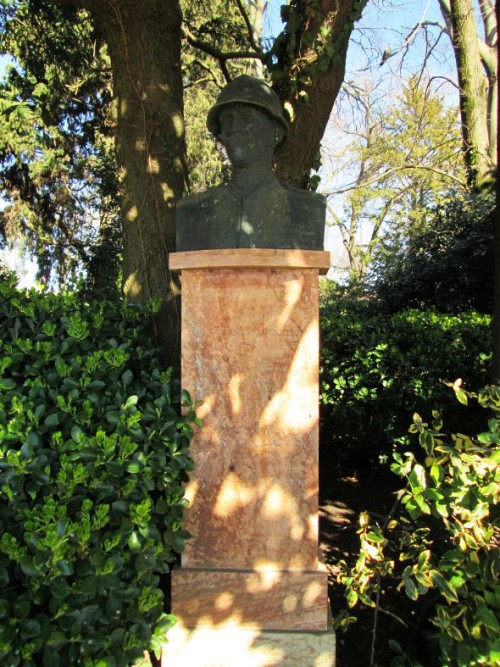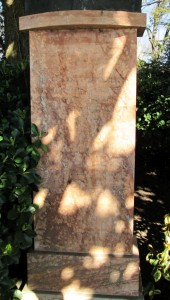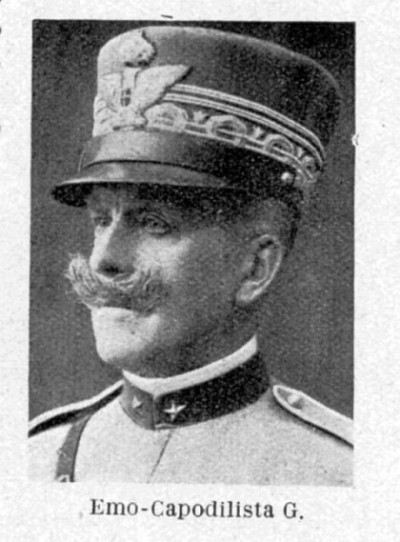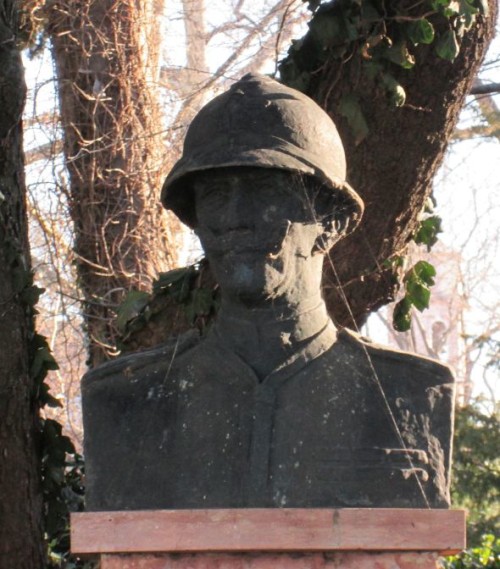
November 4 is a landmark date, the anniversary of the signing of the peace treaty between Italy and Austria in 1918 that ended the First World War. I have drawn attention to this event more than once.
For many reasons, World War I maintains an unusually lively presence in my thoughts here. A new reason, recently discovered, is Giorgio Emo Capodilista, one of Italy’s more heroic commanders in a war which, as far as I can tell, was fabulously deficient in even merely competent commanders. I discovered him posing quietly in the Giardini Pubblici behind some shrubs and lashed to the pedestal by a few stalwart cobwebs. I realize that once-famous people are forgotten every day, but neglect is depressing.
Cast in bronze — and only a third of him, at that — he looks imposing. The moustache is excellent. But one has to picture this man in action: Cavalry. Swords. The infamous Retreat from Caporetto. And a strength of purpose for which bronze is a poor substitute.

PATRIZIO VENETO GENERALE COMANDANTE LA II BRIGATA DI CAVALLERIA REGGIMENTI GENOVA E NOVARA DEGNO FIGLIO DELLA STIRPE SUI CAMPI DI POZZUOLO DEL FRIULI OPPOSE IL VALORE SUO E DEI PRODI AL NEMICO INVASORE PERMETTENDO SALVEZZA DELLA III ARMATA E SBARRANDO LA VIA DI VENEZIA 29-30 OTTOBRE 1917 GIUGNO 1960
Veneto patrician General Commandant of the II Brigade of the Cavalry Regiments of Genoa and Novara Worthy son of the lineage On the fields of Pozzuolo del Friuli opposed his and his courageous ones’ valor to the enemy invader Permitting the deliverance of the III Army and barring the way to Venice 29-30 October 1917 June 1960.
It sounds very neat and contained, the way these things do on inscriptions. One needs context.
The 12th Battle of the Isonzo, better-known as the Battle of Caporetto, was fought from October 24-November 19, 1917 between the Italian and the Austro-Hungarian armies. To fight the preceding eleven battles in the same area had occupied more than two solid years.
The dimensions of the Italian defeat are still difficult to grasp. According to John Farina (“Caporetto: A Fresh Look,” La Grande Guerra):
“Italian casualties totaled 40,000 dead and wounded, over 280,000 prisoners and 3,150 artillery pieces captured. The Italian army was reduced in size by one half, from 65 infantry divisions to 33.
A message carrier, Attilio Frescura, described what he saw at the bridge across the Isonzo at Caporetto:
‘At one end of the bridge a Lt. Col. was screaming that they had to advance across the bridge. At the other end a Captain, with pistol in hand, was ordering everyone “Back! Back!”. Wagons had been dumped in the river in an attempt to clear the bridge. In the meantime, engineers started planting explosives and preparing to blow the bridge before the eyes of thousands of soldiers from the 46th division that were trying to escape across it.’
Frescura delivered his message to Lt. Col Trezzani who “…ordered me and several others to stop the wave of runaways that was flooding the area and sweeping everyone away with them. We blocked them on the roads and stopped those that had their weapons. Those that had no weapons were allowed to continue to not jam things up. But then many of the armed soldiers saw what we were doing and threw away their rifles…
“…the battle had moved to the roads, but the battle was lost. I found an officer from my unit. He yelled at me:
Go or they’ll get us!
I asked:
But what about the others?
Go! Go! Everyone go! Run!
We hopped on the running board of our staff car in which I saw some of the officers of my unit. All around the car was a cowardly mass of humanity grabbing onto the car screaming wildly “Go! Go!”
Even our honor – gone.”
The astonishingly rapid advance of the Austrian forces made it imperative to protect the retreating army. By the evening of the next day (October 25), the entire Italian 3rd Army and what was left of the 2nd Army were at risk of being surrounded. The Italian forces were ordered to retreat to the Tagliamento River, a distance ever so roughly, as the vulture flies, of 56 km/38 miles. The order affected the vast majority of the Italian Army: 700 out of a total of 850 Italian battalions, or about 113,400 men, were ordered to retreat. Almost all of the Italian losses occurred during this hideous interlude, between the Isonzo and the Tagliamento.

This is where Giorgio Emo Capodilista comes in.
On October 29 he and the II cavalry brigade were ordered to reach Pozzuolo del Friuli and defend it at all costs for at least 24 hours in order to to gain the time necessary for the retreating divisions to reach and cross the Tagliamento.
Emo Capodilista knew, as did his commanding officer, that even though this action was essentially a suicide mission, it was absolutely necessary.
Trying to move forward, his brigades, together with the Bergamo Infantry Brigade, were blocked by the retreating troops (note above the character of this phase — chaos, panic, pandemonium), an appalling spectacle which one writer observed had a “negative influence on the morale of the cavalry.” That’s probably an understatement, because the “difficult psychological atmosphere” created a high risk that the dragoons, on their way to fight Austrians, would stop to fight their own countrymen instead.
Having reached Pozzuolo del Friuli, the II Brigade found a situation even worse than it had expected. Emo Capodilista and his men obeyed their orders to resist the advancing Austrians at any cost, battling non-stop for 24 hours in the streets and piazzas of the small mountain town, and on October 30 the troops of the 3rd Army crossed the Tagliamento. Mission accomplished. Mission of near-total immolation also accomplished. In protecting the retreating army, he lost more than two-thirds of his men.
“I was always embarrassed by the words sacred, glorious, and sacrifice, ” wrote Ernest Hemingway. “I had seen nothing sacred, and the things that were glorious had no glory and the sacrifices were like the stockyards at Chicago if nothing was done with the meat except to bury it…Abstract words such as glory, honor, courage…were obscene beside the concrete names of villages… the names of rivers, the numbers of regiments and the dates.”


1 Comment
Hi Erla,
Yes, neglect is really depressing but I suppose that’s the way it goes. Even great heroes and great deeds are gradually forgotten. My own home village was once a battlefield, the place of the last battle on Swedish soil, but now no-one seems to care. The monument still stands, of course, but now so covered with moss and funghi that it’s impossible to read the, unintentionally humouristic, inscription.
Thanks for the history lesson and I’ll be sure to pay the general a visit the next time I pass by the Giardini publici. Just by coincidence I’m currently reading one of Donna Leon’s books, set in Venice, in which they just happened to make references to the battles in Alto Adige. Your post made me more curious about reading more about World War I.